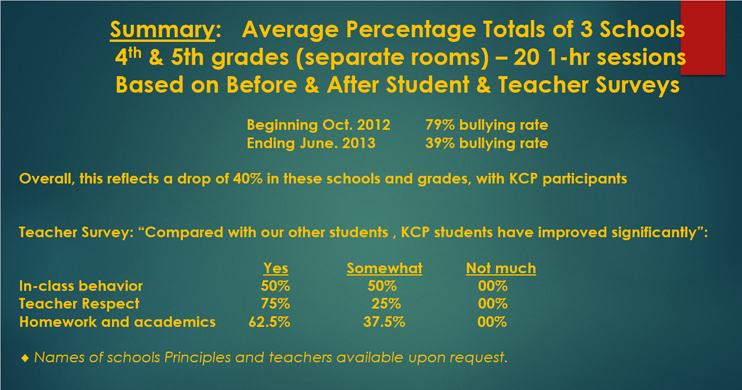Kids Create Peace serves those who will enter and shape our future world. Our programs provide youth and children the skills and understanding to create and bring peace to their own lives, their community and the larger world. We offer guidance and encouragement so each young person can attain the skills and confidence to express and contribute their unique talents. They also learn to work collaboratively, they are empowered to create with others.
Our first program brings that purpose into schools starting in 2011.
Kids Create Peace is the first program of One Voice of Peace. Its purpose, like that of all programs of O.V.P, is to increase harmony and cooperation among people by offering practical tools to enhance communications and to prevent conflict and misunderstanding before it begins. There is no better place to begin this process than at the outset of the lives of young children.
Designed for charter and public school 5th grade classes, the on-going course would be the opening lesson one or two days a week or as an after school program. The program is offered at no cost to schools.
Kids Create Peace Goals:
- Coaching children in learning essential life skills, (e.g. discernment; non-aggressive, non-oppositional communication; deep listening; and leadership).
- Assisting children to discover and be free of limiting or negative concepts and beliefs, and to perceive, speak, and act without judgments that are reactions to the beliefs or actions of others.
- Understanding conflict: how it arises, how to prevent it. Provide tools to resolve conflicts and expand their peacemaking skills.
- Strengthening their connection with and commitment to their family, friends, teachers and other adults, their school and community.
- Engaging children, families, schools and community in creating an enjoyable learning experience of caring individuals who model positive behavior and meaningful interactions.
- Increasing the pursuit and enjoyment of academic excellence that results from increased self-worth and self-esteem.
Methodology:
Kids Create Peace is a one hour session and explores how conflict begins: the cultural assumptions and judgments that cause separation, prejudice, and hostility.
The program introduces a set of concepts, to be understood and applied through experiential, “anchoring” activities: games, role-playing and videos; and written material, like songs, poetry, plays, speeches, quotes, and newspaper and magazine articles. These are chosen and used in ways that allow students to see how patterns of judgmental behavior and conditioned thinking create unwanted “drama”, trauma and stress in their lives – and in the lives of those around them.
And, we demonstrate how easy it is instead to cooperate, appreciate each other (including diversity), and create together. Kids and youth directly experience the shifts they can create in relationships, circumstances and events. Thus they experience themselves as peacemakers!
In summer seminars, school breaks, etc., teachers and other educators are trained in the program’s ideas and in use of its materials. All are independently funded, therefore no added expense for school systems.
Older youth: After the trial period of Kids Create Peace is completed, we are developing a two-level Youth Leadership/Mentoring program: High School youth are co-facilitators/mentors to middle school youth, and middle school youth to elementary age children.
Benefits of Kids Create Peace:
This program teaches kids and youth how to get along, to appreciate each other, to work together from mutual respect. This means it encourages and supports these results:
- Keep children and youth out of trouble
- Reduce conflict and violence – among each other, and within their family environment.
- Replace bullying with friendship
- School is more fun. No fear of being confronted or challenged in halls, rest rooms, lunch rooms, playgrounds, or even in the classroom
- Better grades
- Each child feels respected, have confidence that their unique self is seen and appreciated
- Their different learning styles are supported
- Teachers are no longer distracted by behavior problems, and can devote their time and energy to their true passion: helping kids learn and thrive, intellectually, socially, emotionally
Tools and skills acquired:
- Responsibility
- Accountability
- Deeper listening
- Appreciation of their own and others’ feelings
- Self-esteem
- Creativity
- Empowerment: experience of being “in charge of oneself” – able to affect situations — despite any conditions in their lives
- Social responsibility
- Leadership
In summary: Greater opportunity for academic success – a key to moving up the ladder to a successful life.
Youth Leadership, currently in development, is an expanded extension of Kids Create Peace. Youth Leadership builds on the Four Principles for Living in Peace and teaches high school youth mentoring and leadership skills for working as co-facilitators with kids from elementary and middle schools.
Youth attend a summer youth leadership training center, where they deepen their under-standing and practice of the program’s core ideas and skills. They now act as teachers and mentors of others – teachers, younger children, and interested others in their community.
Engaging Parents and Guardians:
Parents (or guardian/mentor) are supported in attending workshops that teach the concepts, methods and skills their children learn. Follow-up support is included.
Children, teachers and parents create a workbook of home exercises that improve interaction among children, parents and other family members. It also enhances their ability to resolve issues and dissension, reducing stress in the family and adding measurably to the children’s self-confidence as important members of the family matrix.
Stages:
One: Introducing Kids Create Peace to Southern California teachers and educators, and to all other interested organizations. Receive professional educators’ input. Assemble all planning and support materials required.
Two: In Summer or during a school-year holiday, workshops offer the program’s concepts and tools to educators and parents — those expecting to offer it immediately, and others interested in its future use.
Three: Ongoing evaluation, to allow upgrading from experience. Recording of classroom experience: by video and writing (e.g. journaling, by students and teachers).

